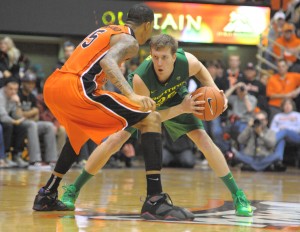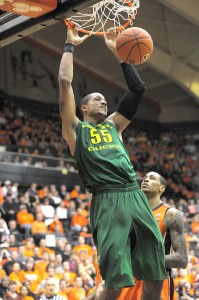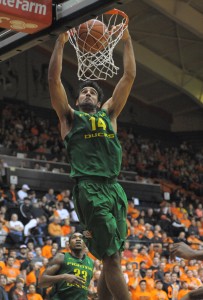The Civil War: For Oregon and Oregon State, One Game Says It All
Posted by Kenny Ocker on January 7th, 2013Kenny Ocker (@kennyocker on Twitter) is an RTC correspondent. He filed this report after Sunday night’s Civil War game between Oregon State and Oregon in Corvallis.
After December drags on with a dearth of meaningful games, the first weekend of conference play is a welcome sight for basketball fans. Everybody wants to see how their teams match up against the schools that matter, and are looking for meaningful results to hang their hopes on for the rest of the season. But as tempting as it is to judge how good your favorite squad really is, it’s still too soon to see what each team’s future looks like just yet. That urge to decide what’s in store is magnified when that first game is the 338th edition of the most-played game in college basketball: the Civil War between Oregon and Oregon State.

Oregon forward E.J. Singler seems to be back on track after a slow start to 2012-13. The senior had 15 points and nine rebounds, the second-highest total in each stat this season. (Photo by Rockne Andrew Roll.)
One game into the Pac-12 schedule, it looks like Oregon is an NCAA Tournament-level squad after taking a 79-66 road win against rival Oregon State in Corvallis. The Ducks have a realistic shot at making the school’s first Sweet Sixteen since an Elite Eight run in 2006-07 led by Aaron Brooks and a host of other shooters. But Dana Altman’s Ducks are a different sort of team than Kent’s free-wheeling, fast-break-loving squad of yore. The 2012-13 version thrives on its defense, led by shot-altering Wake Forest transfer Tony Woods and quick-handed Rice transfer Arsalan Kazemi. Even if the Ducks play at an above-average tempo, they aren’t hanging up the consistent 80-point scores from those days. Instead, they’ve got a stifling defense currently in the top 10 in defensive points per possession, and have enough offense to get by even with senior leader E.J. Singler struggling to regain the form that helped guide the Ducks to the NIT last season. (I’m thinking he shouldn’t have cut his Samson-like locks after last season. His scoring and rebounding are both down this year, as is his once-stellar free-throw percentage, which finally crested 80 percent again Sunday night.)
On Sunday night, freshman guard Damyean Dotson led the Ducks offensively, scoring 21 points on 8-of-15 shooting with two of his team’s three three-pointers. (A 13-point victory, though inflated by late fouls, is all the more impressive given the Ducks’ 3-of-18 shooting from behind the arc.) Singler chipped in 15 points and led the team with nine rebounds, his second-highest output of the season in both statistical categories. He also grabbed a season-high-tying and game-high three steals. Kazemi, fighting the effects of a recent concussion and playing with just one day of practice, came off the bench to score eight points and grab eight rebounds and two steals.

Oregon center Tony Woods is the fulcrum of the Ducks’ much-improved defense. (Photo by Rockne Andrew Roll.)
But with the way Oregon had played in the first half, leaving Corvallis with a win was definitely in doubt. Saying he lost his composure during halftime, Altman criticized his team’s ball movement, which manifested itself in the box score as seven turnovers against three assists, and an 0-of-8 performance from three-point range. Altman said, “We took some bad ones in the first half, just quick. I want them to be confident, I want them to be aggressive, but a bad shot’s still a bad shot.” At halftime, the Ducks faced a 34-28 deficit. “I think all of us were upset with how we played in the first half, we all got on each other and said ‘We’ve got to pick it up, we’re better than this,” Singler said. “I think that helped, that really got us going.”
After halftime was when the Ducks started going off, beginning with a 15-2 run to take the lead. Dotson contributed five of those points with a coast-to-coast jumper in transition and a three-pointer that put Oregon ahead for the first time at 37-36. The Beavers crawled back to take a one-point lead with 11 minutes to go, but from there the game was all Oregon’s. The scale of the second-half comeback, on the road against a rival in a conference game, is something that a bona fide NCAA Tournament team shows. Overcoming poor three-point shooting, poor ball movement and a poor first half and still finding a way to win is impressive, even if it is just one game.

Despite a lingering concussion, Oregon’s Arsalan Kazemi capped the Ducks’ Civil War win over Oregon State with a last-minute slam. (Photo by Rockne Andrew Roll.)
Meanwhile, head coach Craig Robinson’s Oregon State squad has a fatal flaw: It’s Princeton-style passing big men, including spark plug (-shaped) senior Joe Burton and lanky forward Eric Moreland, can’t mesh with its volume-shooting starting guards, Ahmad Starks and Roberto Nelson. Given the gross disconnect between the frontcourt and backcourt, the Beavers’ ceiling is limited by its lack of ball-handling facilitators. Against the Ducks, Starks had 22 points with four three-pointers, and Nelson had 18 of his own. But Oregon State’s starting guards combined to have just one assist and six turnovers. Meanwhile, Burton and Moreland tallied six assists of their own. “They just outplayed us. I think we got a little ahead of ourselves, I just don’t think we didn’t execute as well as they did. They came out with a purpose and played extremely hard. They outplayed us in the second half,” Nelson said.“They were really outworking us, they were just going hard. We weren’t able to run with them.”
There might only be a 45-minute drive between Eugene and Corvallis, but the trajectory of these two schools seems miles apart this season.
– Rockne Andrew Roll (@raroll on Twitter) contributed to this story.











































[…] period. This game helped to clarify some things about that the Pac-12 is going to look like. First, as my colleague Kenny Ocker pointed out, Oregon State’s pass-happy bigs and gunner guards are a pretty flawed combination. They had […]